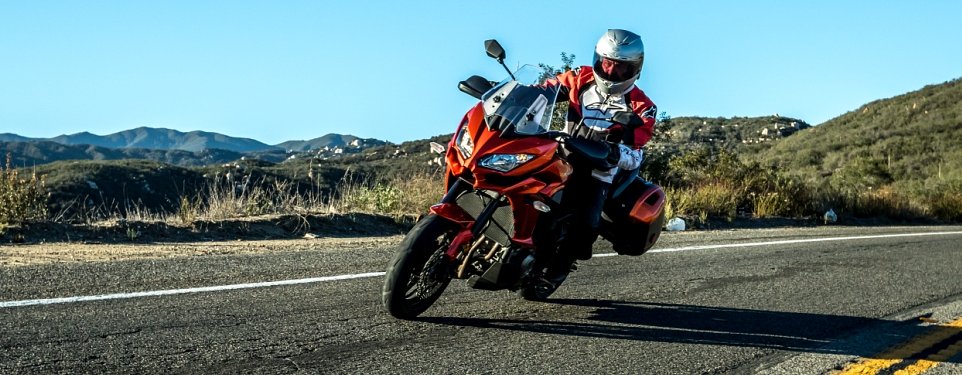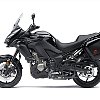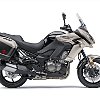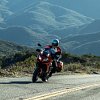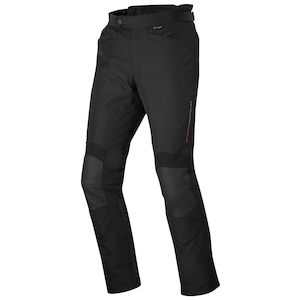We humans can be a whiny lot with our first-world problems.
Give us a latte made from perfectly roasted organic coffee beans from the rich volcanic slopes of Guatemala, and it’s “Ah, the foam is a bit lifeless.” Give us a nimble, versatile, comfortable, do-it-all motorcycle at an affordable price and it’s “Ah, wish it had more power.”
And that brings us to the Kawasaki Versys 1000 LT.

The bike
The Versys 1000 LT belongs to the new and popular class of sport-tourers we’ve written about before that combines some of the styling and stance of adventure-tourers without the off-road pretensions or compromises. Kawasaki unveiled the original 650 cc twin Versys in 2008 and the Europeans have been getting the bigger brother for a few years, but the Versys 1000 LT did not come to the United States until 2015. While the smaller Versys is available in both regular and LT versions, the thou comes only as an LT. And that’s not a bad thing. It makes for a very nicely equipped sport-touring motorcycle, for the price.

The Versys is powered by the 1,043 cc inline four-cylinder engine also found in the Kawasaki Ninja 1000, a sport-tourer in a more traditional sense, and the Z1000 naked bike. The engine is retuned slightly for the Versys and gets taller gearing in the upper gears. As manufacturers often do with their cruiser models, Kawasaki doesn’t talk about horsepower with the Versys 1000 LT, but rather cites a peak torque of 75.2 foot-pounds at 7,500 rpm. Dyno charts I’ve seen put the Versys at around 110 horsepower or a little less. That doesn’t sound like a lot for a liter-sized inline-four, which is probably why Kawasaki neglects to mention it. For sport-touring, however, the nature of the power matters more than peak numbers, and we’ll get to that shortly.
The 310 mm front brake rotors are gripped by four-piston calipers and the 17-inch wheels accommodate sensibly sized 120/70-17 front and 180/55-17 rear tires, so the Versys rider has the full range of sport and sport-touring tires to choose from.
The KYB inverted 43 mm fork and the rear shock both provide 5.9 inches of travel. That contributes to the 33.1-inch seat height. With the saddlebags in place, Kawasaki says the Versys 1000 LT weighs about 570 pounds. The 5.5-gallon tank, the broad seat, the 59.8-inch wheelbase, the roomy bags – it all adds up to a motorcycle that is not exactly a heavyweight, but never feels small.
I have put more than 55,000 miles on a personal Versys 650 that I outfitted with aftermarket parts to resemble the Versys 1000 LT long before the 1000 existed. One of the things I appreciate about the original Versys is its nimble handling. So I was very curious to see if Kawasaki could upsize the Versys to make it more comfortable and capable for long-haul use, especially two-up, without losing that agility and the versatility from which its name was derived.

Testing the Versys 1000 LT
I had the Versys 1000 LT for a week and rode it 1,382 miles, from the city streets of Southern California to droning across the desert on Interstate 15 to some gorgeous back roads in southwestern Utah, including about 270 miles two-up.

The very first thing that caught my attention, even before I put the Versys in motion, was the light clutch pull. The assist and slipper clutch, as Kawasaki calls it, felt smooth and low-effort. Over the course of the week, the rest of the Versys’s controls lived up to that first impression. There’s nothing outstanding here, no fancy TFT display or navigation gizmo, but all the controls are where they should be, work easily and make sense. Scrolling through displays on the LCD screen or changing power modes or KRTC settings was learned in a matter of seconds.
Moving a parked Versys 1000 LT definitely reveals its weight, but once I got underway I was pleased to discover that the weightlifting big brother still retains some family resemblance. No, “nimble” is not the first adjective that comes to mind. But the bike strikes a good balance between willingness to change direction and stability, with a little more rake and trail than the other models that share this Kawasaki engine. The leverage provided by the high, wide handlebar helps, of course, but the weight is simply manageable.
The tune of the four-cylinder engine also helps here. If you’re thinking “peaky four-cylinder,” recalibrate your stereotypes. Because Kawasaki wasn’t going for impressive top-end peak-power numbers, the engineers could focus on producing refined power. Power flows smoothly all across the tach dial, even when trundling around a parking lot at 2,000 rpm. Pulling onto a SoCal freeway to merge with maniacal traffic, the Versys seemed willing to pull hard no matter how fast the engine was spinning. There’s no high-rpm, time-warping, I’m-gonna-die-now burst of acceleration like you get with the race replica liter bikes. Really, I soon found out that revving up to around the torque peak was about as far as I needed to wring the throttle, even in the most urgent need for power.
If you’re looking for insane power, look elsewhere. If you’re looking for sane power, keep reading.

The Versys 1000 LT placed me in an upright riding position with my feet below me where they needed to be so I could stand up over jolts. Taller riders will appreciate the leg room. I'm known as a bit of a whiner when it comes to seats, but I was able to go a couple of hours at a clip before I started noticing this one, so that's better than average. The seat is broad and allows room to move and change positions, but it unfortunately shares the common sin of sloping forward. The engine and handlebar have rubber mounts and I never noticed any vibrations.
My wife joined me for a portion of the trip and appreciated the leg room and passenger seat which, if anything, is more comfortable than the rider’s seat. Her only quibble with the accommodations was that the grab handles were too thick for comfort. In Kawasaki’s defense, she wears size XS gloves.
The windscreen slides up and down about three inches by loosening two clamps on the front, with no tools needed. The ability to adjust the screen anywhere in its height range will accommodate a wider range of riders, but personally I left it in the lowest position most of the time. The screen is wider at the bottom than the top, and raising it provided more wind protection for my shoulders at the cost of more buffeting.
The bit of extra travel in the suspension enabled the Versys to soak up road imperfections. When I got the Versys to myself on some of SoCal’s twistier sections, such as Route 74 through the San Jacinto Mountains and down into Palm Desert, or east of Julian on Route 78, I learned the price to be paid for the smooth ride over less-than-perfect pavement and the stability on the freeway. I was pleasantly surprised that tossing the bigger Versys into the turns never felt like a wrestling match with a pig, but the long-travel suspension feels soft and starts to wallow when the pace picks up.

Versys 1000 LT highlights
The original Versys name was a mashup of Versatile System. One of the highlights of the Versys 1000 LT is that it remains a versatile, do-it-all motorcycle.


The motorcycle’s versatility is also enhanced by this version of the Kawasaki 1,043 cc engine. Peak horsepower of a little more than 100 is not impressive, as a standalone stat. Some 600 cc race replicas exceed that. But the swell of torque that churns out of the Versys engine at any speed is smooth and seamless. Just twist the throttle and surge ahead. I should note that another motorcycle writer I know and trust complained about abrupt throttle action while I experienced not a hint of that. It seriously makes me wonder if there is some inconsistency from bike to bike or if there was a setup problem with another Versys in the press fleet.
The Versys is about competence, not drama. Drama makes for good racing, or at least good benchracing, but not for a comfortable 600-mile day of touring. The Versys 1000 LT makes a very good companion for a 600-mile day.

Versys 1000 LT lowlights
Most of what I thought about putting in this section of the review sounded like a cheap shot, given the price. For example, in his review of the BMW S 1000 XR, Lemmy called out the cheap-looking LCD display. The one in the Versys 1000 LT is similar. But how can I complain when it works well and the motorcycle costs about two thirds of the BMW’s price?

For me, the real low point on the Versys is not so much a fault as it is a part of its personality. Maybe I’m behind the times, but I still think the perfect sport-touring motorcycle is a sport bike made comfortable and nicely equipped for travel. I’m not sold on the concept of these sport adventure bikes, and the reason has to do with height and weight.
The extra suspension travel makes for a smooth ride, but I could not flat-foot this bike, despite my not particularly short inseam of 32 inches. Concentration was required at all times when maneuvering the motorcycle fully loaded with me and the wife in full gear and full saddlebags. Sure, there are lots of heavier bikes out there, but few with a seat height above 33 inches and no off-road pretensions.
Knowing I was going to switch from solo to two-up riding, I was happy to see the remote preload adjuster on the Versys’ rear shock. When I tried to adjust it, it wouldn’t turn. I consulted the manual to see if I was forgetting a step, but no. After an embarrassingly long time, I realized it was already at max preload. The price paid for the smooth ride of the longer suspension travel is a little front-end wallowing at a spirited, one-up pace, or the need for a little more rear-end support when fully loaded.

The competition
Depending on the rider’s mission brief, the competition for the Versys could be extremely wide or just a few other models. I’m going to make an arbitrary but, I believe, defensible decision and limit the competition to motorcycles with 17-inch front wheels. That’s what separates bikes like the Versys from adventure-touring bikes meant for off-pavement use, which have 19-inch or 21-inch front wheels that open up entirely different tire options.
The most obvious competitor is the Yamaha FJ-09. The Yamaha is 70 pounds lighter, makes almost as much power, and costs about $1,535 less when equipped with saddlebags. The Versys probably has the edge in long-distance comfort, but the Yamaha is more nimble and sporty.
Then there’s the upscale European competition, though considering the prices, they’re really not in the same class: the Aprilia Caponord 1200 at $15,499, the Ducati Multistrada 1200 Touring package at $19,000 and the BMW S 1000 XR at $19,345, similarly equipped with saddlebags. Of course the Ducati and the BMW, in particular, are more powerful and offer an array of features the Versys doesn’t have, such as dynamic suspension adjustment, cruise control and more. Though some of those features will cost you extra.
Then there’s the intramural competition of another kind. The Kawasaki Ninja 1000 uses same engine, in different tune, and the same saddlebags. I rode the Ninja just for the sake of comparison and was surprised how different the two bikes felt. The Ninja is the old style of sport-touring motorcycle: a sporty machine made more comfortable for travel. Add the saddlebags and the Ninja ends up costing $270 more than the Versys. The Versys is smoother and offers better wind protection. The Ninja carries over a sportier feel, with the different tune of the engine.

Conclusion
A lot of the decision about buying a Versys depends on how it fits you. Larger riders will appreciate the leg room and the ability to move around. On the other hand, I don't expect a lot of shorter men or women riders to choose a Versys. I know women who are skilled riders and could ride the wheels off the thing, but it probably wouldn't be their first choice, just because of the height.
Off-road riders will consider the Versys 1000 LT a sport bike they feel comfortable with. Sport bike riders will consider it a touring bike. Cruiser riders will find out they don’t have to give up torque to get 100-plus horsepower, and touring bike riders may find there are benefits to shedding a few hundred pounds.
The Versys isn’t spectacular at anything and doesn’t wow you with dynamic suspension adjustment, gear shift assist or other features the Europeans have. Nor does it wow you with the European prices. It’s a competent, smooth motorcycle that does nothing wrong, unless it just plain doesn’t fit you, and it offers a generous array of standard equipment for $12,799. There’s just not much for even a spoiled, first-world motorcyclist to whine about.































 Riders Preferred Membership
Riders Preferred Membership
